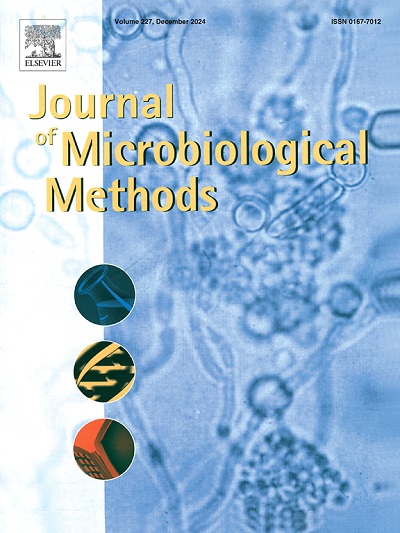用沙门氏菌细菌学分析手册方法测定生宠物食品基质中沙门氏菌的检出限和相对检出限。
IF 1.9
4区 生物学
Q4 BIOCHEMICAL RESEARCH METHODS
引用次数: 0
摘要
每年,由于受污染的宠物食品,都会有多次沙门氏菌召回。成品的常规检测需要可靠、快速、灵敏的检测方法。在本研究中,我们比较了基于培养的参考方法和基于LAMP和PCR原理的两种替代方法的敏感性。评估是在多个试验中进行的,使用具有挑战性的宠物食品基质,在不同的储存时间间隔后进行测试,以更好地解决方法的可靠性。生冻干点心、粗碎和肉饼分别接种少量和高剂量的鼠伤寒沙门菌。冻干生零食和粗碎分别接种0、1、3、5、7和10 CFU/25 g,生肉饼接种0、1、3、5、7、10和30 CFU/25 g。对于培养法,冻干零食、粗碎和肉饼的检测水平(LOD50)分别为0.9、1.1和3.7 CFU/25 g。计算的相对检测水平(relative level detection, RLOD)值接近1 CFU/25 g,说明LAMP和PCR方法的LOD50值与培养法相近。还证实了替代LAMP和PCR方法可以在24 h内提供与参考培养方法相匹配的可靠结果。在应对潜在的宠物食品污染时,更快的响应时间是无价的。本文章由计算机程序翻译,如有差异,请以英文原文为准。
Determination of limit of detection and relative limit of detection of Salmonella in raw pet food matrices using Salmonella bacteriological analytical manual methods
Each year, there are multiple Salmonella recalls due to contaminated pet food products. Routine testing of finished products requires reliable, quick, and sensitive detection methods. In this study we comparatively evaluated the sensitivity of a culture-based reference method and two alternative methods, which are based on LAMP and PCR principles. The evaluation was performed in multiple trials using challenging pet food matrices, which were tested after various storage time intervals to better address the reliability of the methods. Raw freeze-dried treats, kibble, and patties were individually inoculated with Salmonella Typhimurium at fractional and high inoculation levels. Raw freeze-dried treats and kibble were inoculated at 0, 1, 3, 5, 7 and 10 CFU/25 g and raw patties were inoculated at 0, 1, 3, 5, 7, 10 and 30 CFU/25 g. For the culture method, the level of detection (LOD50) values were 0.9, 1.1, and 3.7 CFU/25 g for freeze-dried treats, kibble, and patties respectively. The calculated relative level of detection (RLOD) values were close to 1 CFU/25 g, indicating that LAMP and PCR methods have similar LOD50 values to the culture method. It was also confirmed that the alternative LAMP and PCR methods can provide reliable results within 24 h that match the reference culture method. Faster response times are invaluable when responding to potential pet food product contamination.
求助全文
通过发布文献求助,成功后即可免费获取论文全文。
去求助
来源期刊

Journal of microbiological methods
生物-生化研究方法
CiteScore
4.30
自引率
4.50%
发文量
151
审稿时长
29 days
期刊介绍:
The Journal of Microbiological Methods publishes scholarly and original articles, notes and review articles. These articles must include novel and/or state-of-the-art methods, or significant improvements to existing methods. Novel and innovative applications of current methods that are validated and useful will also be published. JMM strives for scholarship, innovation and excellence. This demands scientific rigour, the best available methods and technologies, correctly replicated experiments/tests, the inclusion of proper controls, calibrations, and the correct statistical analysis. The presentation of the data must support the interpretation of the method/approach.
All aspects of microbiology are covered, except virology. These include agricultural microbiology, applied and environmental microbiology, bioassays, bioinformatics, biotechnology, biochemical microbiology, clinical microbiology, diagnostics, food monitoring and quality control microbiology, microbial genetics and genomics, geomicrobiology, microbiome methods regardless of habitat, high through-put sequencing methods and analysis, microbial pathogenesis and host responses, metabolomics, metagenomics, metaproteomics, microbial ecology and diversity, microbial physiology, microbial ultra-structure, microscopic and imaging methods, molecular microbiology, mycology, novel mathematical microbiology and modelling, parasitology, plant-microbe interactions, protein markers/profiles, proteomics, pyrosequencing, public health microbiology, radioisotopes applied to microbiology, robotics applied to microbiological methods,rumen microbiology, microbiological methods for space missions and extreme environments, sampling methods and samplers, soil and sediment microbiology, transcriptomics, veterinary microbiology, sero-diagnostics and typing/identification.
 求助内容:
求助内容: 应助结果提醒方式:
应助结果提醒方式:


